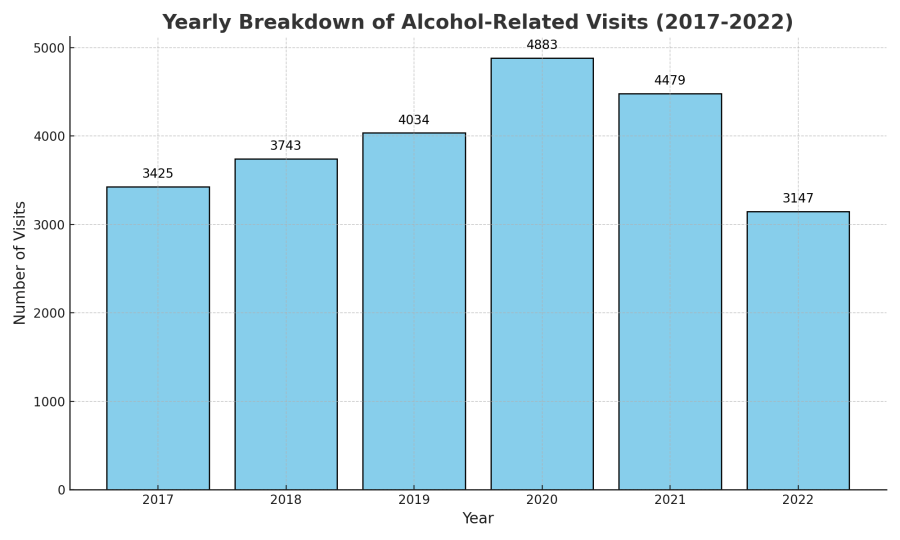CLEVELAND (WJW) – There are more emergency department visits for alcohol than any other drug.
That’s according to new data from the Cleveland Department of Public Health (CDPH).
It shows alcohol continues to be the leading substance associated with emergency department visits in Cleveland, far surpassing other drugs like opioids and cocaine.
“People are not as aware that alcohol is a drug,” said. Dr. Ryan Marino.
Dr. Marino is an emergency room physician and addiction specialist at University Hospitals.
“Yes, alcohol is a drug. It has multiple effects on the body,” he explained.
FOX 8 requested years of data from (CDPH) to get a better understanding of the local impact.
By the numbers
New data from the Cleveland Department of Public Health (CDPH) reveals alcohol was responsible for over 3,300 emergency room incidents in 2023 alone.
Between 2017-2023, more than 27,000 emergency department visits in Cleveland were alcohol related.
Some of the most common diagnoses for the alcohol-related visits include withdrawal, assault and motor vehicle accidents.
Behind alcohol, cocaine is the second most common drug blamed for ER visits.

CDPH data shows during the same time, 5,900 visits related to cocaine use, 5,800 visits related to opioid use, and 4,800 visits related to cannabis use.

Alcohol-related emergency room visits surged during the COVID-19 pandemic in 2020 and 2021, the data shows.
The data also indicates that alcohol-related issues are rising among older adults over the age of 60.

“We’re seeing people age into those groups who are drinking more than generations before them,” Marino said about the data.
It follows a nationwide trend that shows overall alcohol consumption is up.
“One thing the data didn’t show is that overall consumption, nationwide, people drinking alcohol, has increased significantly over the last 10 years, but definitely since the start of the pandemic,” Marino said.
“Alcohol has always been and remains the number one consumed drug in every age group,” he added.
Another issue is more prevalence in binge-drinking, which amounts to 10 or more drinks for males and 8 or more drinks for females, according to the National Institute on Alcohol Abuse and Alcoholism.
What alcohol does to the body
“It acts as a depressant on your central nervous system. The reason people kind of use it to take the edge off, reduce anxiety,” Dr. Marino shared.
“Alcohol causes chronic health problems. Even if you’re not drinking in a way that is necessarily unhealthy,” he said.
“Alcohol is a toxin,” Marino said. “It’s pretty toxic even in small amounts.”
He continued, “It has direct toxicity to pretty much every cell line and organ and tissue system in your body.”
“We know that over time people can get higher rates of liver disease and also it is known to cause cancer,” Marino said.
Despite alcohol’s well-documented health risks, it remains the most consumed drug in the U.S.
Dr. Marino says alcohol plays a big role in other medical issues that are not necessarily documented as alcohol-related, like injuries, high blood pressure and other long-term health problems.
Where do we go from here
“Alcohol is a normalized part of our society and our culture,” Marino said. “It’s so pervasive, and its consumption is so ingrained in daily life, that many people don’t realize the serious harm it can cause.”
He highlighted the importance of education in raising awareness about the risks of alcohol consumption. Marino believes that packaging changes, like those seen with tobacco products, could make an impact.
“I have to believe this contributes to a lack of awareness,” Marino said.
How alcohol is regulated
Federal and state regulations surrounding alcohol remain a point of contention.
While alcohol is considered a food product by the U.S. Food and Drug Administration (FDA), it is not classified as a controlled substance under federal law.
This classification affects how alcohol is regulated, sold and advertised across the country.
Alcohol is regulated by a federal agency called the Alcohol and Tobacco Tax and Trade Bureau (TTB).
The TTB does not require nutritional labeling, which some believe is a public health issue.
#Alcohol #reportedly #responsible #visits #Cleveland









Leave a Reply